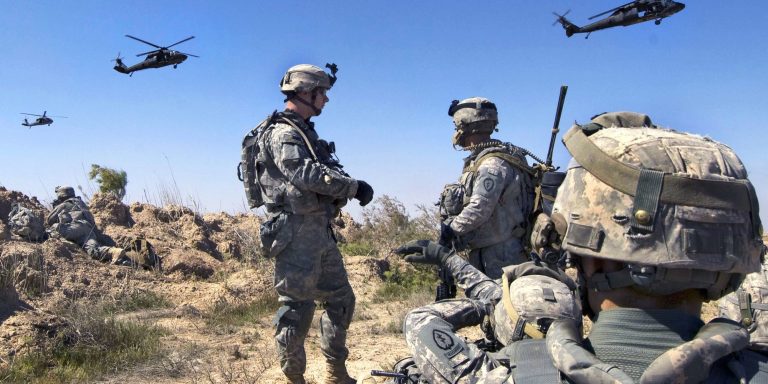INTELBRIEF
November 19, 2018
IntelBrief: The Staggering Cost of the Never-Ending ‘Global War on Terror’

- By October 2019, the U.S. will have spent approximately $6 trillion in efforts related to support of the so-called ‘global war on terror.’
- This figure factors in the true costs of a series of seemingly endless military campaigns, to include debt payments and spending across the government beyond the Department of Defense (DoD).
- The term ‘global war on terror’ has since fallen out of vogue, but the propensity to use the military to resolve complex foreign policy issues around the globe remains a constant of American grand strategy in the post-9/11 era.
- Despite the trillions of dollars spent, the U.S. finds itself with no satisfactory endpoint to any of the myriad armed conflicts overseas the military is engaged in at present.
.
The ‘global war on terror,’ or ‘GWOT,’ and the military-centric strategy underpinning it, endures even as the term itself is no longer common parlance from the Beltway to Baghdad. Since September 11, 2001, one of the strategic priorities of U.S. domestic and foreign policy has been pursuing an open-ended war declared on terrorism, a tactic used by insurgents, guerrillas and militants. After seventeen years, the results of this campaign are mixed, at best. The good news is that there has not been an attack anywhere near the scale of 9/11 in the U.S. since that day, a significant achievement. The bad news is that the ideology that leads someone to fly a plane into a building or drive a car into a crowded sidewalk seems to have metastasized in the nearly two decades since the ‘GWOT’ was first announced. Moreover, many of the conflicts that comprise America’s global counterterrorism campaign have a fiercely local component to them, meaning there is little that a Western country and its military can actually do to impact events on the ground for a sustained period of time. Most victories in the ‘GWOT’ have been ephemeral and fleeting.
The financial costs of the ‘GWOT’ have always been difficult to calculate, partly by design. To fund the ‘GWOT,’ the U.S. government has used emergency appropriations, special legislation and newly created authorities. The result is that it has become exceedingly difficult to know the actual cost in terms of taxpayer revenues expended on a war which now has U.S. military personnel working counterterrorism issues in 76 countries. The U.S. government estimated the campaigns in Afghanistan, Iraq, and now Syria had cost approximately $1.5 trillion since 2001, a figure only attributed to spending by the Department of Defense (DoD).
The real cost goes far beyond the DoD number, since so many other departments and agencies are also focused on counterterrorism. On November 14, 2018, Brown University's Watson Institute for International and Public Affairs released its annual report under the Costs of War study. The report calculated that the U.S. will have spent $5.9 trillion on activities related to the ‘GWOT’ by October 2019. These costs will continue, and actually increase in terms of obligated veterans care and payment on the debt, even if the costs of actual military campaigns decrease. This is to say nothing of the human toll these campaigns have taken, the countless number of Americans killed and wounded in action, and the legacy of post-traumatic stress and other challenges endured by the mere one percent of the U.S. population that volunteers to serve in the military.
The disparity between the U.S government report of $1.5 trillion and the Brown University report of $5.9 trillion is due to the fact that, unlike the government’s estimate, the Brown University study measures the true costs of the conflict, including across-the-government costs. The ‘GWOT’ is, for lack of a better term, a whole-of-government approach that spans multiple departments and agencies. The Department of Homeland Security (DHS) exists entirely because of the war on terror; from 2001 to 2019, DHS and DHS-related spending will be $924 billion, almost a trillion dollars by itself. For years, the Department of Veterans Affairs has struggled to provide adequate care for the growing number of veterans. From 2001 to 2019, the VA will have spent $353 billion on caring for veterans. The study includes future care costs for these veterans, an obligation that will continue for decades. That alone with be $1 trillion between the years 2020 and 2058.
The study also factors in the enormous debt the U.S. has accrued since 2001, as the country has attempted to fight wars without moving fully to a true war footing, particularly in terms of financial commitment and discipline. What is not factored in is the opportunity costs of what the U.S. could have done instead with $5.9 trillion—nation building at home instead of futile, costly and often counterproductive attempts to rebuild nations and societies abroad. The cost savings could be allocated to investing in the American people, with improvements in infrastructure, education, health care, responses to climate change, and the myriad of challenges that affect far more Americans every day than terrorism, but that receive only a fraction of the funding, resources and attention.
.
For tailored research and analysis, please contact: info@thesoufancenter.org